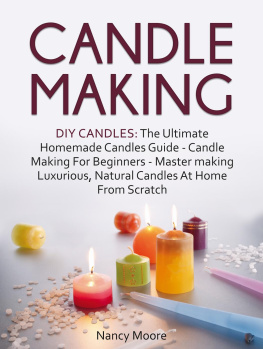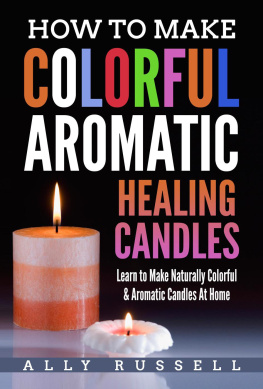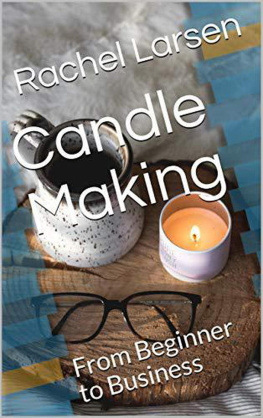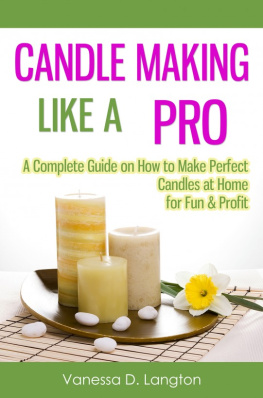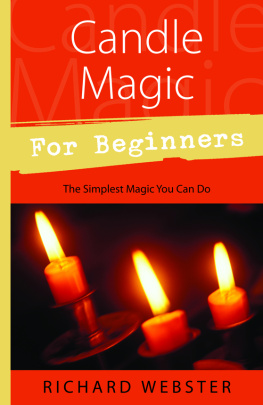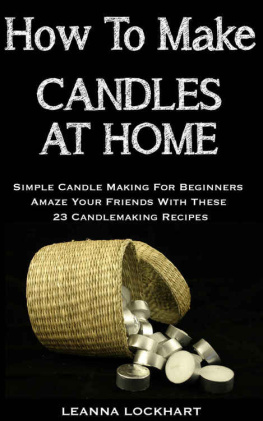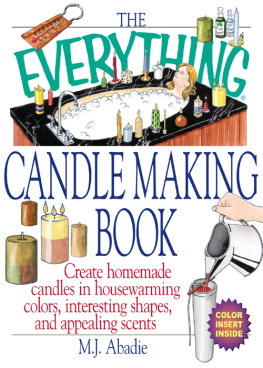Candle Making
DIY Candles - Guide to Making Scented, Natural DIY Candles From Scratch
(Homemade Candles)
Table of Contents
Introduction
C andles used to be a vital part of peoples lives, especially before the advent of electricity. People around the world would use candles to conduct activities during the night, whether that be reading, sitting up late with friends or taking care of sick family members. We needed light, and still do, at all times of the day.
Today, candles are not as necessary, but they are still a common presence in our lives, whether at birthday parties, weddings, holiday events, fine dining or prayers. People like candles because of the calm and celebratory presence they exude, because of the curiosity or reflectiveness generated by the dancing flames and because of their beautiful colors and aromas.
Candles are relatively cheap and easy to find on the market today. Because of that, why would you want to make candles? For some, the pleasure comes from making something they find meaningful or useful. Others want to create a homemade product to gift a friend, colleague or family member. Regardless of your reason, having one will make this process worthwhile.
In this guide, well make candles at a relatively low cost, using a mix of appliances you already have and those provided by the industry. Well primarily be making them in the kitchen, or someplace with a stovetop. This guide will assume that you are an eager learner of candle making with no prior experience. It will prepare you with knowledge about candle types, wax, wicks, dyes and other basic materials needed for candle making.
I hope you will enjoy this guide and find it gives you hope to make candles.
Chapter 1 - Candle Types
W hen you are asked to imagine a candle, what is the first image that comes to your mind? Did you image a long stick of wax sitting on a small plate with a flame atop? Or perhaps around soap-like object burning in a cup? Candles come in a variety of shapes, containers and styles that are crafted with different methods. Several common types of candles, which youll see at weddings, restaurants and decorative events, are container candles, votive candles and pillar candles. I would recommend starting with these types for the beginner candle-maker.
Container Candle
The container candle is such named for its use of a container. The wax fills the container in its entirety, taking the shape of the container. Common types of containers for this candle include heat-resistant glass and ceramic pottery, because these materials tend to do well under exposure to heat. A small wick appears at the center, and it can be burned until all the wax has melted into a viscous pool. The use of glassware that protects and encapsulates the fire of the candle makes this a generally safe, steady type of candle to have around the house, on shelves, on tables and so forth.

P illar Candle
The pillar candle distinguishes itself as a candle that can burn while standing on its own. The candle usually comes in a round, cylindrical shape, although it can also come in square and hexagonal shapes. It is generally molded, meaning that you carve and craft the shape of the candle. A heat-resistant plate or stand is often placed underneath this candle to catch any molten wax that drips off, although if it is wicked correctly, there shouldnt be much dripping.

V otive Candle
The votive candle is like a hybrid between the container candle and the pillar candle.
They are generally small, shaped in a square or cylinder, and rise about 2 inches, the length of a battery cell, and 1 inch diameter. The votive candle is generally placed in a container larger than itself, so that it burns initially like a pillar candle, but then appears more like a container candle as the wax melts to fill the container.
The candle received its name from its common use as a votive offering in Christianity. Traditionally, it is burnt at altars and churches as an act of prayer. The candle can also be burnt during many other occasions, including during dinners and holiday gatherings.

Chapter 2 - Knowing Your Materials
T his chapter covers a variety of materials that youll need to know about before beginning to make candles. To make this as unintimidating as possible, this chapter is broken up into sections and will contain subheadings and some pictures to guide your learning.
Wax
Wax is the basic material for making candles and varies depending on the type of candle you want to make. The melting point of the wax helps you decide which wax is suitable, as different types require different melting points. Among the three types in this guide, container candles have the lowest melting point of the wax, votive candles come in second and pillar candles have higher melting points, which is necessary because they need to stand on their own and cannot become a messy pool. The following are the recommended melting points for each type:
130F (55C) or lower melting point of wax is most suitable for container candles because melted wax is easily contained.
129F - 142F (53C - 60C) melting point is suitable for making votive candles.
134F - 147F (56C - 63C) melting point is suitable for making pillar candles.
These melting points can be found in each of the wax materials outlined below, although each will also have specific properties that suit certain candle types more than others.
Paraffin
Paraffin wax is the most common type of wax used in candles around the world. Imagine a small pillar candle, and youll likely imagine a candle that is white and smooth, made of paraffin wax. It is synthesized by industrial methods of removing the waxy substance from unrefined petroleum. The abundance of petroleum, compared to natural oils, beeswax or animal fats, paraffin has allowed paraffin to reach the popularity it has today. Paraffin is available at a variety of melting points and is used in candles of all types.
S oy
Soy wax is a vegetable-based candle wax made as a natural alternative to the paraffin waxes. The process of making this type of wax is coincidentally similar to making trans fats: by hydrogenating soybean oil. Soy waxes that are made of 100% soybean oil are best used as container candles as a result of their low melting points. They can also be blended with other waxes, such as palm or paraffin, to create wax blends of a variety of melting points, properties and fragrances, giving you benefits from multiple wax sources.
P alm
Palm is a vegetable-based candle wax and another natural alternative on the market, made in the same way as soy waxes are. Palm wax tends to have very firm qualities, making it a good candidate for votive and pillar candles, although some container candles have been found to use palm wax as well. Its texture produces a lovely feathered design in candles.
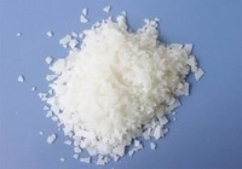
W ax blend
Wax blends are commercial wax products that blend a variety of waxes to create a wax with specific characteristics and qualities for your needs. Wax blends will often recommend a type of candle to be used for will be labeled with melting point and will note its fragrance retention, or the ability to produce fragrance as the candle is being burned.
Next page
